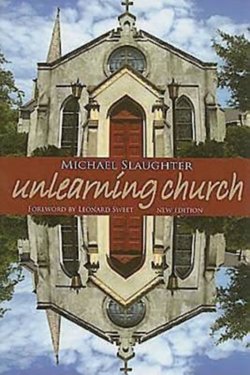Читать книгу UnLearning Church - Mike Slaughter - Страница 9
На сайте Литреса книга снята с продажи.
ОглавлениеUnLearning churches defy old identities.
They don't fit into the usual categories.
They're tough to label, difficult to classify,
and downright unpredictable. UnLearning
churches are based on shared life in
Jesus—not issue-centered ideology. The
people at the helm are fully dependent on
the leading of the unseen Spirit of God.
"Church growth" was the mantra of the 1980s and 1990s. I attended my first "Breaking the Two Hundred Barrier" conference shortly after becoming Ginghamsburg's pastor in 1979. Then I enrolled in "Breaking Four Hundred" and "Breaking Eight Hundred."
We became experts at methodologies that involved small group and Sunday school ministries. When it was trendy to do so, we shifted from a programmatic approach to a cell-driven approach.
We began to develop associations around the successful megachurches of that day. We learned about the pastor as CEO, and I adopted that model. In the late 1990s, I really thought the contemporary megachurch would be the church of the future. It was the kind of church almost everyone seemed to aspire to become. Our culture preferred Wal-Mart superstores to the corner drugstore and giant Home Depots to local hardware stores. It made sense for churches to follow that same pattern.
To move forward, I have had to unLearn the megachurch and CEO models. If we continue to copy the models of the 1980s and 1990s, we're going to miss the next generation. I'm now learning to take my cues from the age-group that's under thirty-five. A one-size-fits-all approach toward growth will definitely not be the most effective model of the twenty-first century.
Change is so constant today that no one can predict the effective church of the future, yet I don't believe it will be the shopping-mall-size megachurch. As many growing churches have demonstrated, once you exceed an attendance of four hundred, a majority of growth can be transfer growth from already-churched populations. Some megachurches have seen success in reaching unchurched populations, but too often church growth in the United States and Canada does not represent net gains for the kingdom of God.
A seismic shift is occurring in the practice of church. Emerging churches are defying many of the formulas of the late-twentiethcentury church-growth movement. The newest islands of health and hope are not the "Fortune 500 churches"—the established models of the 1980s and 1990s that everyone was trying to clone. A new breed of churches is emerging, led by a new generation of young innovators who noticeably resist trying to duplicate the successful church-growth models of the last century.
